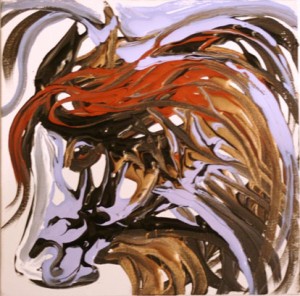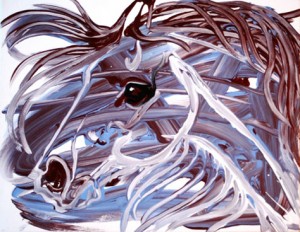totally unconstrained and painting their own story. www.willafrayserstudio.com
Eyespots may be a form of mimicry in which a spot on the body of an animal resembles an eye of a different animal to deceive potential predator or prey species; to draw a predator’s attention away from the most vulnerable body parts; or to appear as an inedible or even dangerous animal.In larger animals, eyespots may play a role in intraspecies communication or courtship – the most well-known example is probably the eyespots on a peacock’s display feathers. The white spots on the back of Felid ears serve a social function, by communicating the animal’s mental state (excited, calm, aggressive, etc.) to conspecifics in the gloom of dense forest or in tall grass.
The eye-like markings in some butterflies and moths and certain other insects, as well as the Sunbittern (a bird) do not seem to serve a mimicry function. In some other cases, the evolutionary function of such spots is also not understood. There is, however, recent evidence to suggest that eyespots in butterflies serve as an anti-predatory device, by either scaring off potential predators or deflecting attacks away from vital body parts.Butterfly eyespots may also play a role in mate recognition and sexual selection,playing a similar role to the eyespots found on larger organisms mentioned above. Pattern formation of concentric spots is probably less complex than the
conspicuous eyespots might suggest; it cannot be ruled out that eyespots are simply a morphogenetic “spandrel” which in any one particular case may or may not have been adapted for a particular function.
To finish I thought it would be nice to include the story below …
WHY THE PEACOCK’S TAIL HAS A HUNDRED EYES.
JUNO, queen of the gods, had the fairest cow that any one ever saw. She was creamy white, and her eyes were of as soft and bright a blue as those of any maiden in the world. Juno and the king of the gods often played tricks on each other, and Juno knew well that the king would try to get her cow. There was a watchman named Argus, and one would think that he could see all that was going on in the world, for he had a hundred eyes, and no one had ever seen them all asleep at once, so Queen Juno gave to Argus the work of watching the white cow.
The king of the gods knew what she had done, and he laughed to himself and said, “I will play a trick on Juno, and I will have the white cow.” He sent for Mercury and whispered in his ear, “Mercury, go to the green field where Argus watches the cream-white cow and get her for me.”
Mercury was always happy when he could play a trick on any one, and he set out gladly for the field where Argus watched the cream-white cow with every one of his hundred eyes.
Now Mercury could tell merry stories of all that was done in the world. He could sing, too, and the music of his voice had lulled many a god to sleep. Argus knew that, but he had been alone a long time, and he thought, “What harm is there in listening to his merry chatter? I have a hundred eyes, and even if half of them were asleep, the others could easily keep watch of one cow.” So he gladly hailed Mercury and said, “I have been alone in this field a long, long time, but you have roamed about as you would. Will you not sing to me, and tell me what has happened in the world? You would be glad to hear stories and music if you had nothing to do but watch a cow, even if it was the cow of a queen.”
So Mercury sang and told stories. Some of the songs were merry, and some were sad. The watchman closed one eye, then another and another, but there were two eyes that would not close for all the sad songs and all the merry ones. Then Mercury drew forth a hollow reed that he had brought from the river and began to play on it. It was a magic reed, and as he played, one could hear the water rippling gently on the shore and the breath of the wind in the pine-trees; one could see the lilies bending their heads as the dusk came on, and the stars twinkling softly in the summer sky.
It is no wonder that Argus closed one eye and then the other. Every one of his hundred eyes was fast asleep, and Mercury went away to the king of the gods with the cream-white cow.
Juno had so often played tricks on the king that he was happy because he had played this one on her, but Juno was angry, and she said to Argus, “You are a strange watchman. You have a hundred eyes, and you could not keep even one of them from falling asleep. My peacock is wiser than you, for he knows when any one is looking at him. I will put every one of your eyes in the tail of the peacock.” And to-day, whoever looks at the peacock can count in his tail the hundred eyes that once belonged to Argus.
Eyespot information from http://en.wikipedia.org





One Response
Willa Frayser
I love this story Carmel! I knew about the eyes on animals and had seen them on butterflies! But until I did these paintings, I had never heard what they were called and what they meant. Thank you for exposing that for me and for sharing my Abstracts! Hugs, Willa